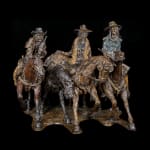

Gib Singleton
Companeros
Bronze
26h x 36w x 26d
Edition of 25
'When you think of the Old West,' Gib said, there's a tendency to think of the good guys. You know, rugged cowboys, noble Native warriors, brave lawmen, the cavalry coming...
"When you think of the Old West,' Gib said, there's a tendency to think of the good guys. You know, rugged cowboys, noble Native warriors, brave lawmen, the cavalry coming over the hill. But there was another side, too. The guys in this piece are Comancheros, and they are not nice guys. In fact, they're pretty bad dudes.' The Comancheros made their living as middlemen between the Plains tribes and settlers along the Rio Grande Valley: They got their name from trading with the Comanches throughout the Comancheria, an area that encompassed eastern New Mexico, northwestern Texas, most of Oklahoma, southwestern Kansas and southeastern Colorado.
'They were mostly Hispanic, Gib said. 'New Mexicans. But there were white guys, too, and Natives. In fact, you can see from his coat that the guy on the right is a former Indian scout for the U.S. Army.'
To the locals, the Comancheros were not only respectable businessmen, but also the only ones who could provide a lot of the things they needed. They traded whatever they could, Gib said. The stuff of white civilization was in big demand among the tribes. Tools, cloth, knives, flour, sugar, tobacco, beads... In return, the Comanches traded hides, jerky and livestock. Especially rustled horses and cattle. But the thing that made the Comancheros so dangerous was that they also traded whiskey and guns for slaves.
When you look at the sculpture, you see they have a packhorse. And that's what's under the tarp - whisky, guns and ammunition. You put those in a Comanche's hands and you have a recipe for disaster.*
The Comancheros knew they were playing with fire, and there are stories about how they would trade their whiskey, but make sure not to actually have it with them. 'They'd hide it somewhere, Gib said, 'and only lead the Indians to it when everything was concluded and they had a two or three day head start with the herds and slaves. Then a couple guys on fast horses would lead the Comanches to the whiskey and light out. And they didn't always make it home.
This all started in the late 1700s and it went on until after the Civil War. In fact, what finally did them in was that when the U.S. Army came back west after the war, they took on the Comanches and the Comancheros sided with the tribes. That was a bad mistake, man. The Army was willing to do business with these guys. A lot of those stolen horses and cattle - and rumor has it, even some of the slaves - went to the Army. But once the Comancheros openly sided with the enemy, the Army came down hard. They whipped the Comanches and Kiowas pretty good, and herded the ones they didn't kill onto reservations. That was the end of the trade, and the end of the Comancheros. 'That's the lesson here. The world changed around these guys and they didn't recognize it and change with it. You do that, man, and life will deal you out.'
- JOHN GOERLER
'They were mostly Hispanic, Gib said. 'New Mexicans. But there were white guys, too, and Natives. In fact, you can see from his coat that the guy on the right is a former Indian scout for the U.S. Army.'
To the locals, the Comancheros were not only respectable businessmen, but also the only ones who could provide a lot of the things they needed. They traded whatever they could, Gib said. The stuff of white civilization was in big demand among the tribes. Tools, cloth, knives, flour, sugar, tobacco, beads... In return, the Comanches traded hides, jerky and livestock. Especially rustled horses and cattle. But the thing that made the Comancheros so dangerous was that they also traded whiskey and guns for slaves.
When you look at the sculpture, you see they have a packhorse. And that's what's under the tarp - whisky, guns and ammunition. You put those in a Comanche's hands and you have a recipe for disaster.*
The Comancheros knew they were playing with fire, and there are stories about how they would trade their whiskey, but make sure not to actually have it with them. 'They'd hide it somewhere, Gib said, 'and only lead the Indians to it when everything was concluded and they had a two or three day head start with the herds and slaves. Then a couple guys on fast horses would lead the Comanches to the whiskey and light out. And they didn't always make it home.
This all started in the late 1700s and it went on until after the Civil War. In fact, what finally did them in was that when the U.S. Army came back west after the war, they took on the Comanches and the Comancheros sided with the tribes. That was a bad mistake, man. The Army was willing to do business with these guys. A lot of those stolen horses and cattle - and rumor has it, even some of the slaves - went to the Army. But once the Comancheros openly sided with the enemy, the Army came down hard. They whipped the Comanches and Kiowas pretty good, and herded the ones they didn't kill onto reservations. That was the end of the trade, and the end of the Comancheros. 'That's the lesson here. The world changed around these guys and they didn't recognize it and change with it. You do that, man, and life will deal you out.'
- JOHN GOERLER

